Keeping a furry friend off the bed is a familiar challenge for pet owners. Cat hair on the sheets and the struggle to reclaim one’s bed can be frustrating despite our deep affection for these beloved family members.
Cats choose our beds for various reasons, including comfort, warmth, and the familiar scent of their human companions. This makes our beds a favorite spot, often preferred over their designated cat beds.
If you want to encourage your cat to sleep in its own bed, redirecting this behavior requires understanding, patience, and the right strategy.
This article offers helpful tips and effective strategies for pet owners looking to create a new place for their cat’s sleep, ensuring everyone in the family enjoys their space at night.
Understanding cat behavior and the significance of territorial and scent marking, providing attractive alternatives, and ensuring the comfort and security of your cat’s bed—these insights will guide you in creating a harmonious living arrangement for all.
How to Keep Cat off Bed: Understanding Cat Behavior
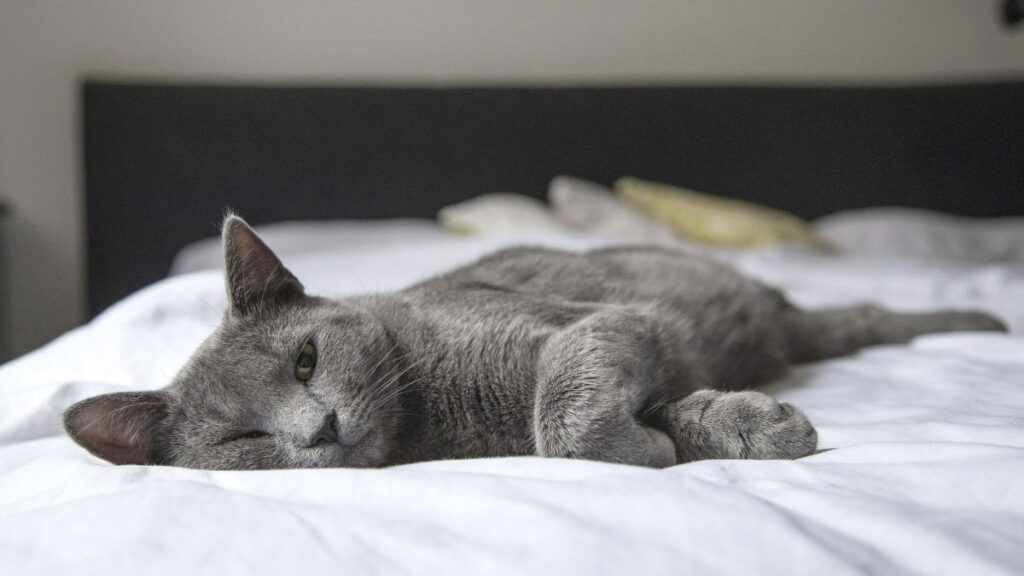
To effectively keep cats off beds, it’s important to understand why they are drawn to them in the first place.
Reasons Cats Prefer Human Beds
Cats are often attracted to human beds for their comfort and warmth. Beds provide a soft and insulated environment, appealing to cats, as they naturally seek out cozy spots for rest.
Additionally, cats may gravitate towards this furniture to feel closer to their humans since cat owners spend much time in bed.
- Comfort: Soft, cushioned surface
- Warmth: Retains heat effectively
Significance of Territory and Scent
Territory is a key concept in a cat’s behavior. Cats mark their territory by leaving their scent, making them feel more secure.
Human beds carry the scent of their owners, and by lying on the bed, a cat mingles its scent, reinforcing the bond and establishing a presence within its territorial domain.
- Scent-marking: Sharing and mingling scents with the owner
- Territorial behavior: Establishing presence by leaving their scent
Age-Related Preferences in Older Cats
As cats age, their preferences can change. Older cats might seek the added comfort and support of a human bed due to potential joint pain or arthritis.
They may also prefer their owner’s scent nearby to provide reassurance and calmness.
- Comfort for Aging Joints: Extra cushioning favorable for older cats
- Seeking Reassurance: Familiar scents for comfort in later stages of life
Understanding these behaviors is crucial for cat owners wishing to redirect their feline’s sleeping habits.
Knowledge of what drives an indoor cat, whether it’s the search for a comfortable spot or a place marked with their owner’s scent—often left by items like an old t-shirt—can assist in finding suitable alternatives to human beds.
Healthy cats may adapt more readily to changes, while older cats might require extra consideration for their comfort and well-being.
Preventive Measures
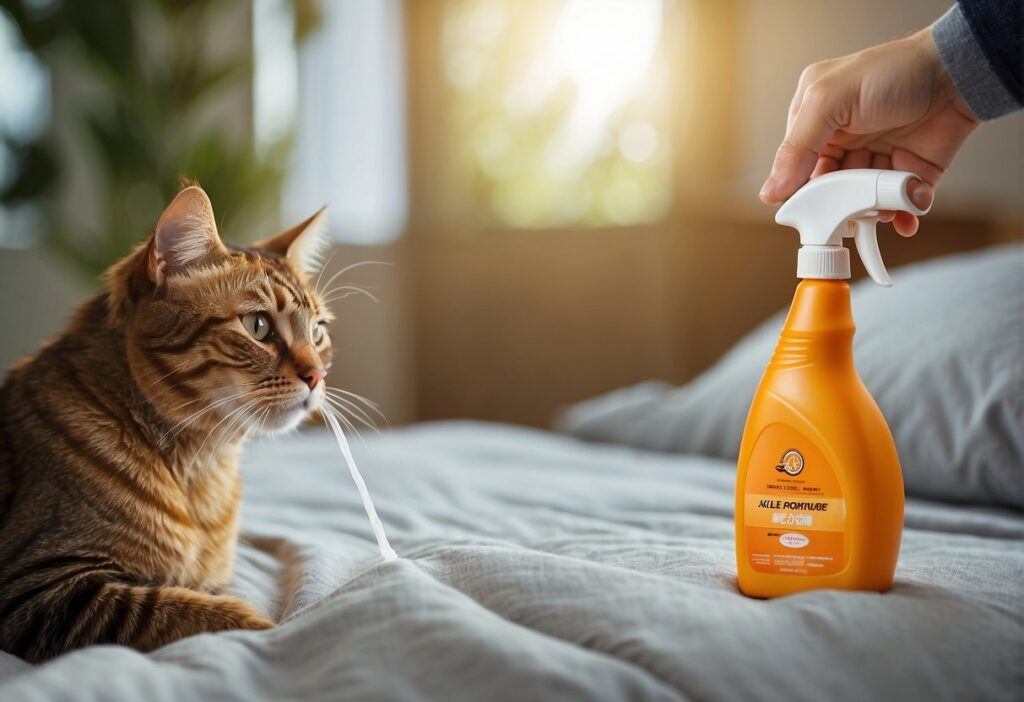
To effectively deter cats from sleeping on beds, owners should consider a combination of physical barriers and olfactory deterrents.
Setting Up Physical Barriers
The first step in preventing a cat from accessing the bed is to create a physical barrier.
One common and simple method is to keep the bedroom door closed.
If the door needs to remain open, other methods, such as placing aluminum foil on the bed, can be effective.
Cats dislike the sound and feel of aluminum foil, and its presence can deter them from attempting to jump onto the bed.
- Physical Barrier Options:
- Keep the bedroom door shut.
- Lay aluminum foil on the bed.
Utilizing Strong Odors
Cats have a strong sense of smell, and certain essential oils can emit unappealing odors.
Scents like lavender, citrus, and peppermint can be used to keep cats away. However, some essential oils can be toxic to cats, so they should be used cautiously and kept out of direct contact with the animal.
These deterrents can be applied around the bed or on bedding that is not used by the cat to avoid any health risks.
- Odor-Based Deterrents:
- Lavender essential oil: Repellant scent.
- Citrus scents: Strong deterrent.
- Peppermint oil: Double-check safety for cats.
Using these preventive measures can be an effective way to maintain a cat-free space on your bed. It’s essential to consider the safety and comfort of your pet while implementing these strategies.
Training Your Cat
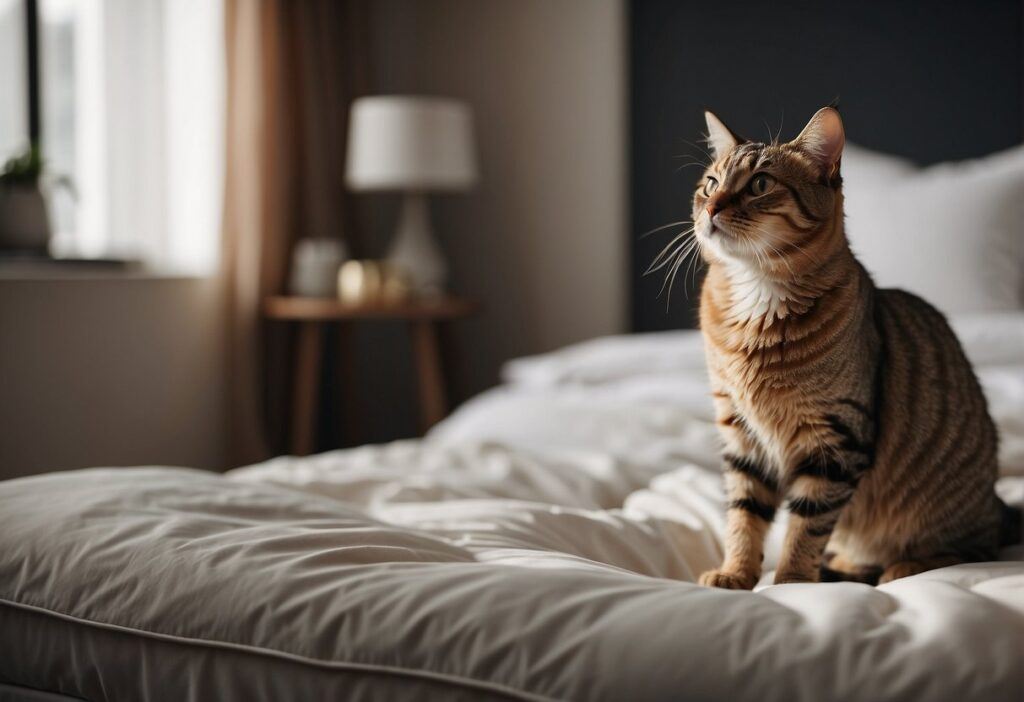
A practical approach to keeping cats off beds involves positive reinforcement and clicker training. These techniques reinforce desired behaviors without punishing the cat for unwanted actions.
Positive Reinforcement Techniques
Positive reinforcement encourages cats to repeat behaviors that are rewarded.
When the cat exhibits a preferred behavior, such as sitting on a cat bed instead of a human bed, promptly reward it with a treat or affection.
Consider the following steps:
- Identify a Reward: Select a treat or activity your cat loves.
- Timing is Key: Deliver the reward immediately after the good behavior.
- Consistency: Consistently reward the desired behavior to establish a clear pattern.
- Patience: Training takes time, so be patient as your cat learns.
By consistently rewarding your cat, it will associate the desired behavior with positive outcomes, making it more likely to repeat the behavior.
Clicker Training Basics
Clicker training is a precise and effective method to teach cats new behaviors and discourage unwanted behaviors.
- First Step: Start by associating the clicker sound with a treat. This creates a positive connection with the click sound.
- Behavior Training: When your cat performs correctly, immediately click and follow with a reward.
- Incremental Training: Start with simple behaviors and gradually introduce more complex tasks.
Using a clicker can effectively communicate with your cat. The distinctive sound helps them understand which behavior is rewarded, promoting quicker learning.
Creating Attractive Alternatives
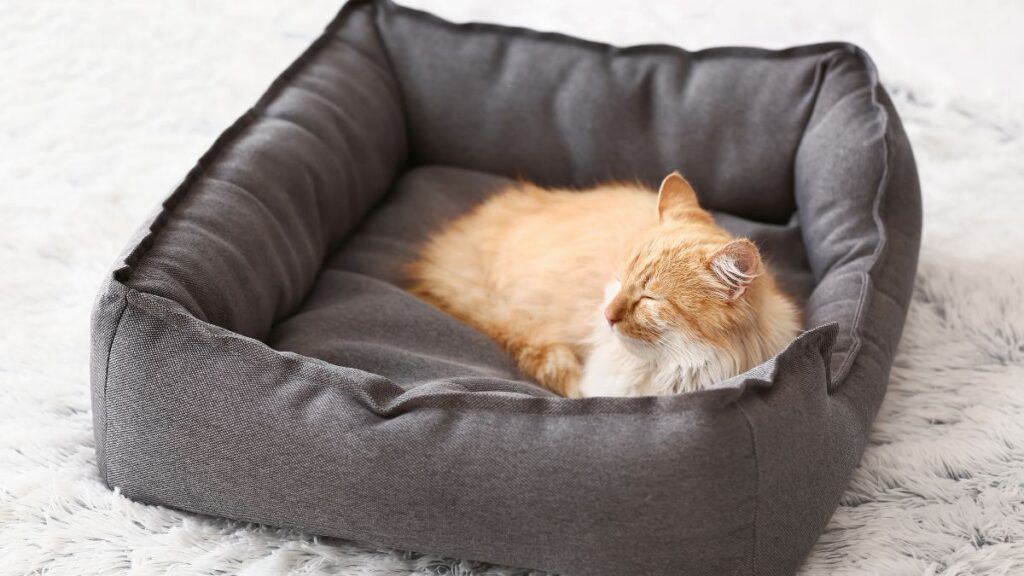
Providing appealing alternatives is crucial to keeping a cat off the bed. Ensuring these alternatives are as inviting as their favorite spots will encourage the cat to use them instead.
Choosing the Right Cat Bed
Selecting a cozy cat bed can divert your cat’s attention from your bed.
Consider the following features for the best cat beds:
- Comfort: Soft materials like cotton or fleece align with your cat’s search for comfort.
- Size: Ensure the bed is large enough for your cat to stretch out and small enough to feel snug.
- Security: Raised edges or a semi-enclosed design can provide a sense of safety.
The location of the new bed also plays a vital role. It should be in a quiet area away from the home’s high-traffic areas.
Providing Vertical Spaces and Perches
Cats have an instinct to climb and observe their environment from above. Vertical spaces and perches satisfy these needs. Integrate these into your home:
- Cat Trees: These structures often combine multiple levels and lounging areas.
- Window Perches: A perch by the window allows a cat to watch outdoor activities.
When placing these items, ensure they are stable and secure to prevent accidents. Position them near areas your cat frequents to increase their attractiveness.
Related: Deciphering Feline Gestures: The Meaning Behind Your Cat’s Raised Paw
Deterrent Strategies
To effectively keep cats off the bed, it is essential to apply deterrent strategies that are safe for the cat and non-damaging to the furniture.
These strategies rely on deterrents that cats typically find unpleasant while being humane and considerate of the feline’s well-being.
Employing Double-Sided Tape
Physical barriers can be an effective method to deter cats.
Using double-sided tape on the bed creates a surface cats dislike because of its sticky texture.
Cover the edges of the bed or any particular area the cat favors with tape strips.
- Location: Apply along the perimeter of the bed.
- Frequency: Replace when no longer sticky or after the cat has learned to avoid the area.
Implementing Scent-Based Repellents
Cats have a strong sense of smell and are naturally averse to certain strong smells.
Scent-based repellents can keep cats off the bed without causing harm.
- Examples of Strong Smells: Citrus scents, menthol, or eucalyptus.
- Application Method: Use a diluted solution in a spray bottle or place scent emitters nearby.
Consistently using these scent-based repellents can send a clear message to the cat and help maintain your set boundaries.
What works for one cat may not work for another, so finding the right solution may require hard work and experimentation.
Repeat the process until you achieve the desired effect and the cat chooses to avoid the bed the next time.
Environmental Enrichment
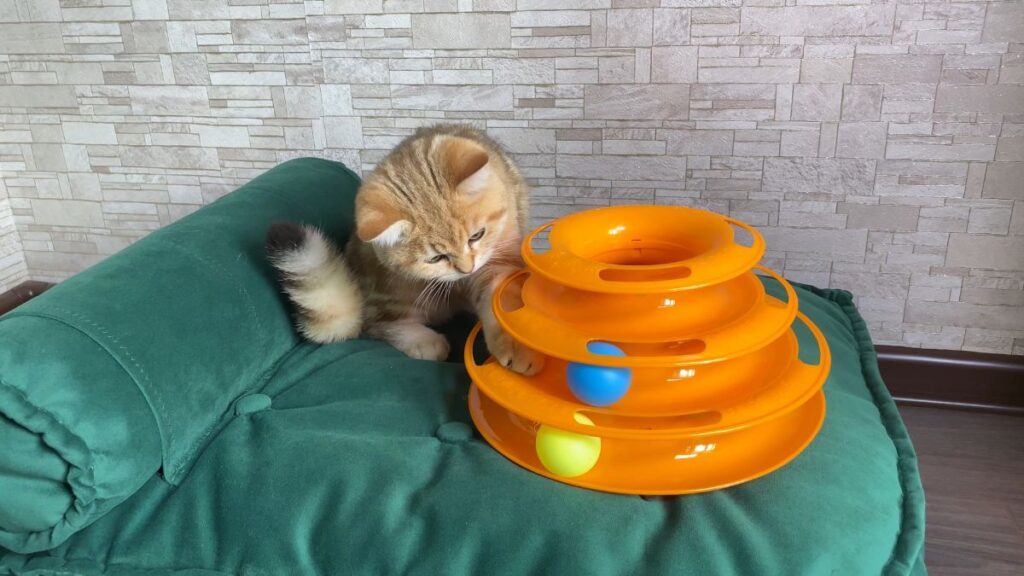
Cats need engaging environments to deter them from seeking forbidden areas, such as a person’s bed.
Providing sufficient stimulation and dedicated areas for a cat can reduce the desire to invade human spaces.
Ensuring Plenty of Playtime and Entertainment
Cats thrive when they have access to various engaging toys and activities.
Offering a selection of toys can keep a cat entertained for hours, preventing boredom and reducing the likelihood of them seeking comfort on a bed.
Window perches can also be a stimulating lookout point, allowing cats to observe the outdoors from a safe vantage point.
Consistent playtime ensures that cats receive adequate exercise and mental stimulation.
- Toys: Balls, feathers, interactive puzzles.
- Activity: Daily play sessions, rotating toys to maintain interest.
Designating Specific ‘Cat Zones’
Creating specific areas in a home where a cat can claim territory can encourage positive associations with these ‘cat zones.’
This discourages bed-seeking behavior by reinforcing the cat’s sense of ownership in designated spaces.
- Cat Trees: Structures that offer climbing and scratching opportunities.
- Beds: Comfortable cat beds placed in quiet areas.
- Perches: Elevated platforms near windows or in social areas.
Comfort and Security
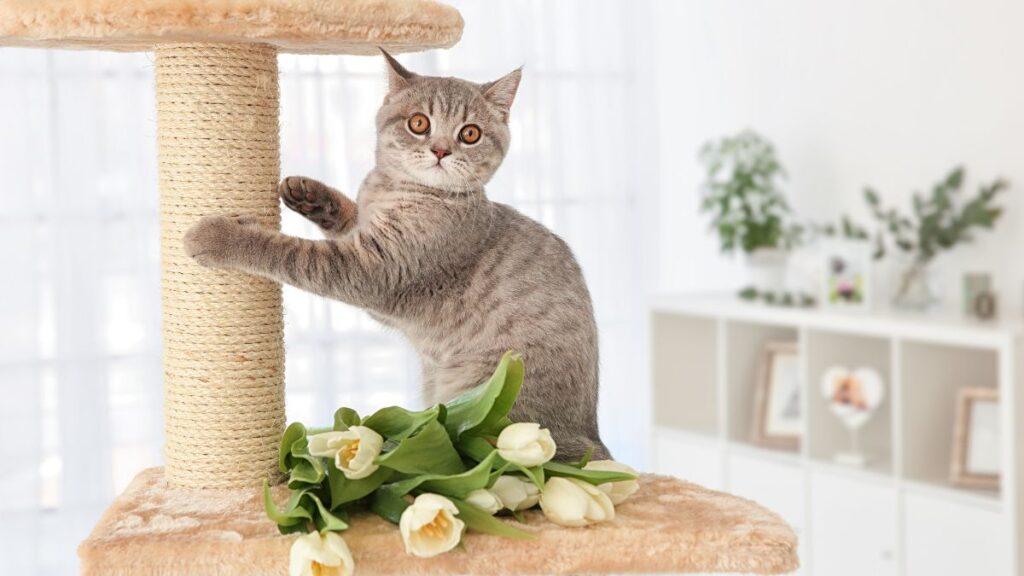
Creating a dedicated space for your cat to call its own will often discourage it from seeking comfort on your bed. Providing security and an attractive area that suits all of your cat’s needs is essential.
Providing a Safe Space for Your Cat
For a cat to achieve a good night’s sleep, it requires a safe space.
This space should be quiet, secluded, and away from the household’s high-traffic areas. The location should also be consistent—not shifting daily—to establish a sense of permanence and security.
- Location: Choose a low-traffic spot.
- Consistency: Keep the safe space in the same location.
Ensuring Comfort in the Designated Cat Area
Cats prioritize comfort when choosing their sleeping spots. Therefore, the designated area should include a cat bed with a soft blanket or pillow that invites the cat to snuggle and relax.
- Bedding: Provide a soft, plush surface.
- Temperature: Maintain a warm and comfortable environment.
The goal is to create a comfortable place that rivals the allure of your bed, leading your cat to prefer its particular area for those rejuvenating naps and a peaceful night’s sleep.
Related: Decoding the Secrets of Feline Acrobatics: Why Cats Vocalize During Leaps
Professional Assistance
Sometimes, cat owners may face persistent challenges with their pets, such as keeping cats off the bed, despite trying various tactics.
In these cases, professional help may be the most effective solution.
When to Seek Help from a Behaviorist
Owners should consider consulting a behaviorist when standard interventions have failed and their cat continues to access the bed, especially if the cat is skittish.
Behaviorists are trained to assess animal behaviors and create customized strategies to alter them.
They use a combination of observation and behavioral techniques to address issues and can provide guidance tailored specifically to your cat’s personality and habits.
Seeking professional help is a pragmatic step for owners committed to setting consistent boundaries within the home.
Introducing Cory Haasnoot, a devoted father, loving husband, and enthusiastic cat lover. As a key content creator for CatFurLife.com, Cory blends his family values and passion for felines into engaging and informative content. He brings a unique perspective to the site, sharing cat care tips and how cats can enrich family life and bring joy to households.

